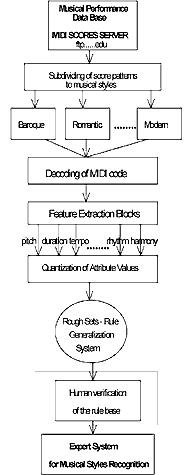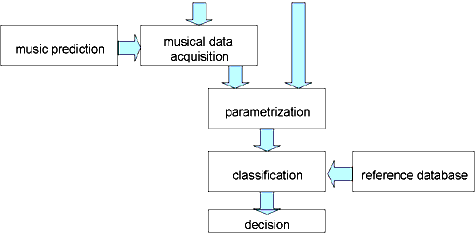| "Human Supervision and Control in Engineering and Music" |
| Workshop | Orchestra Concert | Ensemble Concert | About us |
Dr Bozena Kostek
Expert System for Musical Style Recognition
AbstractIn this overview some concepts concerning sound engineering, computer music and human supervision are presented. Multimodal-computer interactions consist in, among others, collecting and intelligent searching music related-information. Some concepts related to the author’s experience will be presented. Key findings in sound engineering allow recording music in a natural way. Computers can be employed as both Internet sites collecting music-related data and as algorithmic tools that enable musicians to find needed information. They allow analyzing a given melody, modify it in musically sensible ways, mimic the human way of composing, etc. Human supervision is needed at both stages. The quality of recording cannot be assigned otherwise than subjectively. Organizing a computer site containing music-related information needs also the supervising of the future user. Developing artificial intelligence algorithms and designing ergonomic user interfaces is also a task for a human supervisor.
IntroductionDue to the rapid development of multimedia technology, the amount of audio data stored on various computer sites grew significantly. Consequently, a problem is to find methods that allow one to effectively explore a huge collection of data in order to find needed information.
Specifically, the problem is to recognize objects within audio
material.
An example of the multimodal approach consisting in computer-user
interaction
will be presented here. This particularly concerns the recognition of a
musical phrase or musical style. The starting point of this process is
to build up an expert system. It is possible and even suggested to use
a collection of data stored at the ftp server containing large database
of music encoded in MIDI. In Fig. 1 an algorithm for creating such an
expert
system is presented, although procedures marked in a dotted line block
represent learning tasks not used in the recognition mode. In a
training
mode human supervising of the classification of score patterns to a
particular
musical style is necessary. The next step is the decoding of the MIDI
code.
Such a block provides the core for the feature extraction procedure. In
that phase all attributes available in the MIDI code patterns are
decoded.
The next block in the algorithm denotes the extraction of musical
parameters
out of pitch and notes duration decoded from the MIDI code. The
quantization
block is necessary to build up the learning system. For the purpose of
this approach the rough set-based classification is used. Quantized
values
of musical parameters will feed the rough sets-based algorithm as the
condition
attributes. Several concepts will be derived according to a musical
style.
As a decision attribute the musical style class number will be chosen.
The results of creating rules by the rough sets-based algorithm must be
verified by the human supervisor during the learning phase.
Learning Approach to the Musical Style RecognitionLearning approach to the problem of computer-human interactions can be found in the rich literature, a few examples of which are given in References.

Fig. 1. Lay-out of the experimental system for the automatic
recognition
of musical styles (learning tasks)
Searching for a given musical phrase can be based on another approach, which is presented schematically in Fig. 2. To this end a prediction module is applied. This approach needs some additional steps such as for example pitch extraction stage. Based on the conducted experiments it can be said that a learning approach to musical data analysis is generally justifiable, because the number of possible melodies stored on computer sites is infinite and one should employ artificial intelligence for such tasks.

Fig. 2. Lay-out of the experimental system for the prediction of
musical
phrases
ReferencesBello, J.P., Monti, G. & Sandler, M. (2000). Techniques for automatic music transcription, Proc. ISMIR.
Coates, D. (1994). Representations of the MONK Harmonisation Systems, Proc. of Workshop held as part of AI-ED 93, M. Smith, A. Smith, A. Wiggins (Eds.), Edinburgh, Scotland, 25 August 1993, pp. 77-91, Springer Verlag, London.
Desain P. & Honing H. (1991). The Quantization of Musical Time: A Connectionist Approach, Music and Connectionism, P. M. Todd & D. G. Loy (eds.), pp. 150-169, The MIT Press, Cambridge, Massachusetts, London, England.
Holland, S. (1994). Learning About Harmony with Harmony Space: An Overview, Proc. of Workshop held as part of AI-ED 93, M. Smith, A. Smith, A. Wiggins (Eds.), Edinburgh, Scotland, 25 August 1993, pp. 24-40, Springer Verlag, London.
Hörnel, D. (1997). MELONET I: Neural Nets for Inventing Baroque-Style Chorale Variations, in Advances in Neural Information Processing 10 (NIPS 10), Jordan, M.I., Kearns, M.J., Solla, S.A. (Eds.), MIT Press.
Kostek, B. (1998). Computer Based Recognition of Musical Phrases Using The Rough Set Approach, J. Information Sciences, 104, pp. 15-30.
Kostek, B. (1999). Soft Computing in Acoustics, Applications of Neural Networks, Fuzzy Logic and Rough Sets to Musical Acoustics, Studies in Fuzziness and Soft Computing, Physica Verlag, Heildelberg, New York.
Mozer, M.C. (1991). Connectionist Music Composition Based on Melodic, Stylistic, and Psychophysical Constraints, Music and Connectionism, P. M. Todd & D. G. Loy (eds.), pp. 195-211, The MIT Press, Cambridge, Massachusetts, London, England.
Papaodysseus, C., Roussopoulos, G., Fragoulis, D., Panagopoulos TH. & Alexiou C. (2001). A New Approach to the Automatic Recognition of Musical Recordings, J. Audio Eng. Soc., 49 (1/2).
Slade, S. (1991). Case-based reasoning: a research paradigm, Artificial Intelligence Magazine.
Smith, M., Smaill, A. & Wiggins, G.A. (Eds.). (1993). Music Education: An Artificial Intelligence Approach, Proc. of the World Conference on Artificial Intelligence in Education, Edinburgh.
RAA (Recognition and Analysis of Audio. (2000). European project. http://www.iua.upf.es/mtg/raa